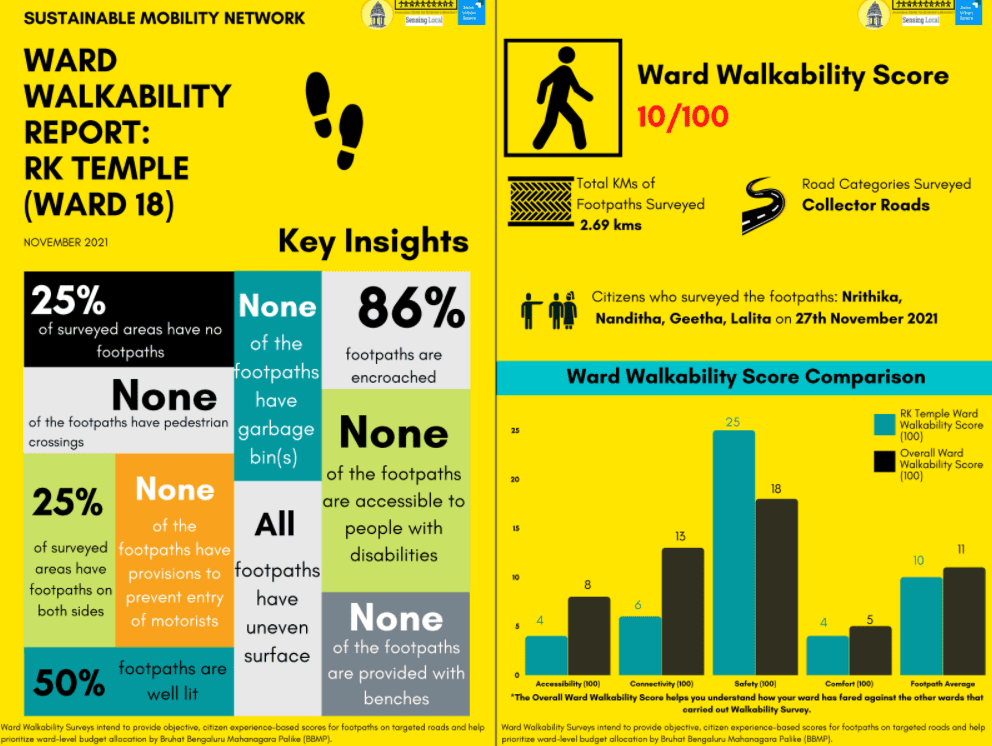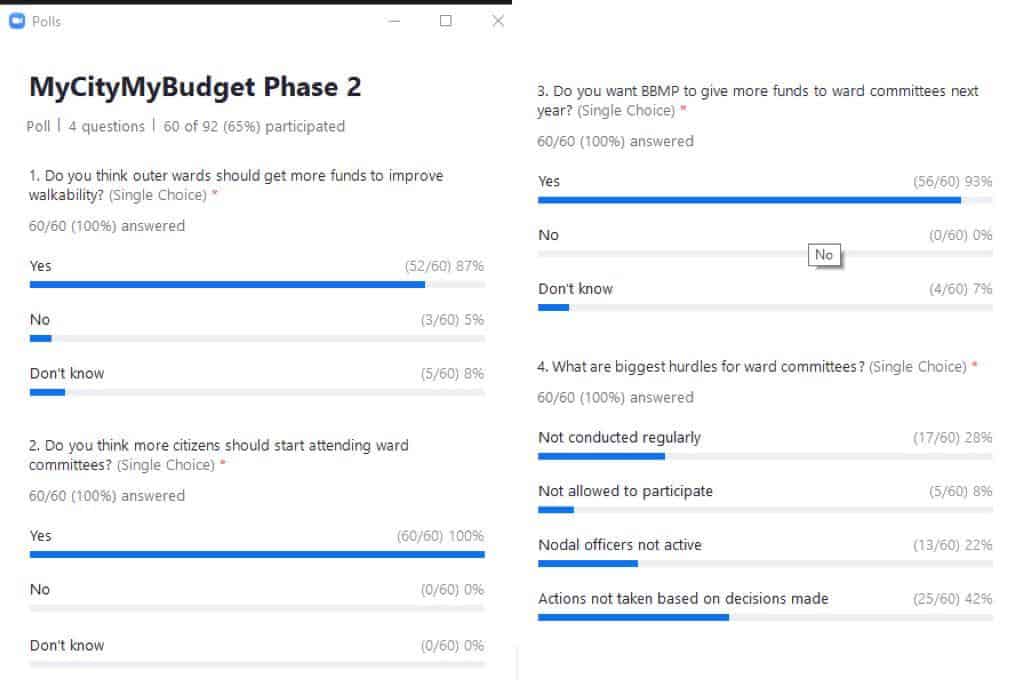Citizens from different wards of Bengaluru were joined by those across the country to participate in Janaagraha’s #CityPolitics webinar, titled ‘MyCityMyBudget Phase 2 – Are Ward Committees using budget allocated to them’, on Saturday, January 22nd. The webinar discussed how Bengaluru’s ward committees have been utilising the budget allocated to them.
Last August, BBMP set precedent by allotting Rs 60 lakh to each of its 198 ward committees. The decision was taken after over 9,000 citizens submitted inputs on how ward budgets need to be spent, in response to the #MyCityMyBudget (MCMB) campaign (jointly launched by BBMP and the NGO Janaagraha).
Speaking at the webinar, BBMP Special Commissioner (Finance) Thulasi Maddineni said, “After we received citizen budget inputs through the #MyCityMyBudget campaign, we wanted to incentivise citizens to participate in their ward affairs by giving them a chance to decide. Citizens are the biggest stakeholders in ward development and maintenance. Citizens need to continuously engage with their urban local bodies to ensure ward development.”
She added, “Bengaluru has a reputation for active citizen participation. Allotting Rs 60 lakh to each of the ward committees was an act of faith in our citizens. Ward committees are like grama sabhas, and we now have regular meetings in most wards; just like grama sabhas, ward committees can be noisy but order comes out of chaos.” Maddineni is also nodal officer in charge of ward 19 (Sanjaya Nagar), and presides over ward committee meetings there.
Read more: Everything you must know, as Bengaluru marks a milestone in local governance
Speaking on how the budget needs to be spent, Maddineni said, “Of the Rs 60 lakh, Rs 20 lakh allotted to potholes has been used in October 2021, to speed up the work. The details on where the money is used are available with the Ward Engineer for the ward committee. With regard to Rs 20 lakh for footpaths, Janaagraha is taking up the Footpath Walkability Survey with citizens to help prioritise works. The works will be decided as per the inputs submitted by citizens in the ward committee. BBMP is also maintaining close to 10,000 borewells, and Rs 20 lakh is allotted for their maintenance and repair.”
“We are nearing the end of January. Citizens can submit their inputs in the ward committees, which will help us decide where the work needs to be taken up and funds used,” Maddineni added.
Srinivas Alavilli, Head, Civic Participation, Janaagraha, said, “Participatory democracy in urban areas has been restricted to academic discussions and largely remained wishful thinking, but not anymore in Bengaluru. Today we heard from so many citizens how they worked together in their own ward committees and made concrete plans on how to use the Rs 60 lakh fund allocated to them. BBMP is making great strides in institutionalising citizen participation by conducting ward committee meetings and allocating funds to ward committees. We urge more citizens to get involved locally and taste the power of community engagement and ownership.”
Ward Walkability Survey in five focus wards
To decide on the footpaths that need to be developed, Janaagraha has been working with ward committees as part of MCMB Phase II. Janaagraha has conducted walkability surveys in five wards, in association with Jana Urban Space Foundation, Sensing Local and with the help of citizens.
The walkability of each ward was measured across four broad footpath parameters – accessibility, connectivity, safety and comfort – using a total of 12 indicators. Both sides of the footpath were taken into account while assigning the score.
Additionally, the quality of pedestrian walkability was measured over five indicators which primarily recorded the presence of footpaths and pedestrian crossings that enable ease of crossing the road network.
In Banaswadi (ward 27), a total of 9.5 km was surveyed. The ward received a Ward Walkability Score of 26 out of 100. Gottigere (ward 194) received a score of 17/100, based on the survey of 8.9 km of roads. Sanjay Nagara has scored 2/100 for the 3.45 km surveyed. R K Temple (ward 18) has scored 10/100 based on 2.69 km surveyed, and Varthur (ward 149) 0/100 for the 2.4 km surveyed. [Click the link on each ward name to see the respective ward’s report. Please note that the score is reflective of only the surveyed streets, and not the entire ward!]

Survey participants shared insights
Citizens who had participated in the survey shared their insights at the webinar.
Amith Nigli and Christopher Cruz, representing Banaswadi, explained how they drew up plans to identify vulnerable roads. Speaking on budget allocation, Christopher said “60 lakhs is negligible to start with. Yet, it is still something good to relay our hopes on!” Amith Nigli said, “Unless we work together and understand how the system works, we cannot bring the change we all seek.”
Swarupa Kakumanu and Poongothai from Gottigere ward said they used the walkability index to identify footpaths and roads that needed the most attention. “Google Forms were created for collecting people’s opinions and the same were addressed while drafting a plan for civic works,” Poongothai said. Citizens appreciated the proactive nature of Nodal Officer Ramamani. Swarupa said they made sure that voices of all sections of society were heard in their ward committee and borewell funds were utilised where there was a need.
Jagadish Reddy, Co-Founder of the citizens’ group Varthur Rising, discussed the need for more funds in larger wards: “Varthur is a large ward. Thus, Rs 60 lakh is inadequate when it comes to repair and maintenance of assets. This is a great beginning, but we hope that BBMP will allocate more budget that can be utilised by citizens in our ward.”
Geeta Gooty from Sanjaya Nagara highlighted the importance of civic participation in effective maintenance of a ward. Lalitha Mohan of RK Temple ward explained how they assessed the requirements of the ward: “We zeroed in on two factors with regard to footpaths – proximity to the neighbourhood schools and the connecting roads that are used often. Based on this, we finalised where the work needed to be done.”
Citizens from Ahmedabad, Mumbai, Bhubaneswar, Hyderabad and Chennai joined the discussion virtually. They commended the efforts in Bengaluru to strengthen ward committees, and wished to see similar initiatives in their own cities. Citizens from different parts of Bengaluru participated in the interaction and brought out many suggestions and highlighted the problems they face in their wards.
An online poll was conducted during the session. Hundred per cent of respondents opined that more citizens must participate in ward committees. And 87% felt that BBMP should allocate more funds for footpaths.

When asked about the biggest hurdles to ward committees, 42% pointed to the lack of action following ward committee decisions, and 28% pointed to the lack of regular meetings. That only 28% respondents highlighted the lack of meetings, conveys that more ward committee meetings are indeed being held. A Janaagraha study in September 2021 had shown that nearly 4000 ward committee meetings happened in our city between July 2020 and August 2021!
Read more: Tough questions, brilliant ideas at Shanthinagar ward committee meeting
Phase 2 of MyCityMyBudget campaign
MCMB’s Phase II is the implementation phase, where the vision of 1,000 km of walkable footpaths across the city – with at least 5 km of walkable footpaths per ward – would get actualised. Janaagraha aims to facilitate the utilisation of Rs 20 lakh budgetary allocation (out of the total of Rs 60 lakh) per ward, towards improving footpaths through the participation of citizens, ward engineers and nodal officers. This phase will enable end-to-end citizen-led execution and supervision of allocated funds.
For further details, please contact:
- Mahalakshmi B – 9986016557
- Srinivas Alavilli – 9945402662
Watch the full recording of the webinar here.
[This article is based on a press release from Janaagraha, and has been published with edits.]